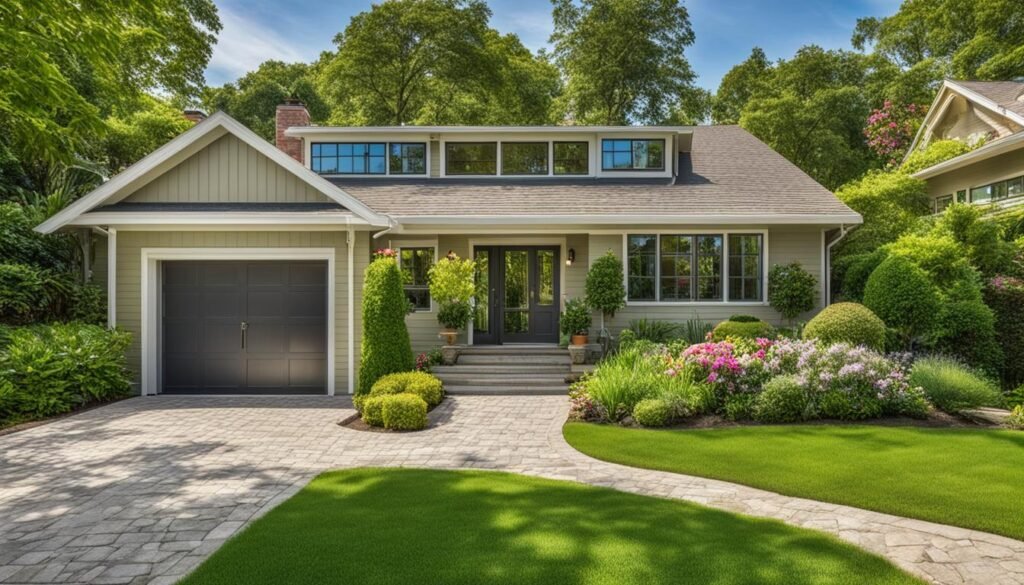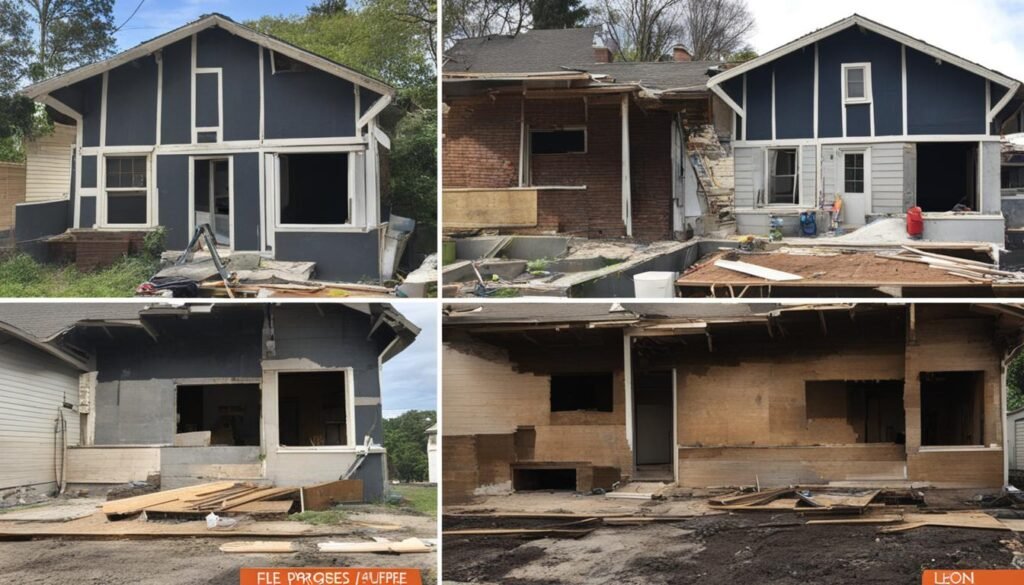A home renovation loan can be the key to transforming your current property or purchasing a new one in need of repairs or renovations. Whether you’re looking to update your kitchen, add a new bathroom, or create more living space, a home renovation loan provides the funds to make your dream home a reality. With options like personal loans, home equity loans, and government-backed loans, you can find the financing that suits your needs and budget.
When considering a home renovation loan, it’s important to understand the various factors that can impact your financing options. Your credit score, loan amount, interest rate, and loan term all play a role in determining the best loan for your home improvement project. Additionally, the type of financing you choose will depend on the equity in your home, your personal financial situation, and the scope of your renovation project.
With competitive interest rates and flexible repayment terms, a home renovation loan offers many benefits over other forms of financing, such as credit cards or unsecured personal loans. These loans can help you pay for home repairs or improvements while potentially lowering your overall interest rate. By leveraging the equity in your home, you can access the funds you need to create the home you’ve always wanted.
In the next section, we’ll explore the different types of home renovation loans available to borrowers, allowing you to make an informed decision about the best option for your project.
Key Takeaways:
- Home renovation loans provide the funds to transform your current property or purchase a new one in need of repairs or renovations.
- Options include personal loans, home equity loans, and government-backed loans.
- Credit score, loan amount, interest rate, and loan term are key factors in determining the best loan for your project.
- Home renovation loans offer competitive interest rates, flexible repayment terms, and potentially lower overall interest rates compared to credit cards or unsecured personal loans.
- By leveraging the equity in your home, you can access the funds you need to create the home you’ve always wanted.
Types of Home Renovation Loans
When it comes to financing your home renovation project, there are several types of renovation loans to consider. Each loan option offers unique benefits and is tailored to suit specific needs. Let’s explore the different types of home renovation loans available:
FHA 203(k) Loan
The FHA 203(k) loan is backed by the Federal Housing Administration and is an excellent option for borrowers looking to include the cost of renovations in their mortgage. This loan allows you to purchase a property or refinance your existing home while also financing the necessary repairs or improvements. The FHA 203(k) loan offers flexibility and convenience, making it an attractive option for many homeowners.
HomeStyle Renovation Loan
The HomeStyle Renovation loan, offered by Fannie Mae, is another popular choice. With this loan, you can finance the cost of both buying and renovating your home. One unique feature of the HomeStyle Renovation loan is that it allows you to take into account the completed value of the project when determining the loan amount. This means you can potentially borrow more funds to cover the full cost of renovations.
VA Renovation Loan
The VA Renovation loan is specifically designed for veterans and active-duty military members. With this loan, you can purchase a property that needs repairs or updates and include the cost of renovations in the loan. The VA Renovation loan offers competitive interest rates and flexible options, making it an excellent choice for those who have served our country.
These renovation loan options provide homeowners with the funds they need to make improvements to their properties. Whether you’re buying a fixer-upper or looking to renovate your current home, these loans offer a range of benefits and loan terms to suit your specific needs and budget.
Benefits of a Home Renovation Loan
A home renovation loan offers numerous benefits for homeowners looking to improve their property and create their dream home. With flexible financing options, you can purchase a property and finance the necessary renovations through a single loan, eliminating the need for multiple loans or credit cards. This streamlined approach simplifies the financing process and provides greater convenience.
One of the key advantages of a home renovation loan is the ability to customize your home according to your specific needs and design preferences. Whether it’s a kitchen remodel, bathroom upgrade, or creating additional living space, you have the flexibility to transform your home into the perfect living space that reflects your personal style.
By making improvements to your property, you not only enhance your living experience but also increase its value. Renovations can significantly boost the market value of your home, making it a sound investment for the future. This increased property value can provide you with potential profits if you decide to sell your home down the line.
Home renovation loans often come with lower interest rates compared to credit cards or unsecured personal loans, enabling you to save money on interest payments. Additionally, if you opt for a fixed-rate option, you can benefit from consistent monthly payments, allowing for better financial planning and budgeting.
What’s more, the interest paid on your home renovation loan may be tax-deductible, providing additional financial savings. This tax advantage can help offset the overall cost of your renovation project and potentially increase your tax refund.
“A home renovation loan not only provides the necessary funding for your project but also offers the opportunity to personalize your living space and increase the value of your property. With lower interest rates and tax-deductible interest, it’s a smart financing choice for homeowners looking to create their dream home.”
The benefits of a home renovation loan summarized:
- Flexible financing options to purchase and renovate a property in one loan
- Ability to customize your home to meet your specific needs and design preferences
- Potential to increase the value of your property with renovations
- Lower interest rates compared to credit cards or unsecured personal loans
- Fixed-rate options for consistent monthly payments
- Tax-deductible interest, providing potential financial savings
By taking advantage of a home renovation loan, you can turn your current property into the home of your dreams while also enjoying the financial benefits that come with increasing your property’s value.
Qualifying for a Home Renovation Loan
Qualifying for a home renovation loan is a process that requires certain criteria to be met. Lenders assess your creditworthiness based on several factors, including:
- A good credit score
- Stable income
- Low debt-to-income ratio
A good credit score demonstrates your ability to manage credit responsibly, which is an important factor for lenders. A stable income provides assurance that you have the financial means to repay the loan. A low debt-to-income ratio indicates that you have a manageable level of debt in relation to your income.
In addition to these factors, you will need to provide a detailed renovation plan and cost estimates for the repairs or improvements you plan to make. This helps lenders understand the scope of the project and evaluate the loan amount accordingly.
The loan application process involves submitting documentation to support your loan request, such as proof of income and assets. Depending on the type of loan, you may need to use your home as collateral, utilizing the equity you have in your property to secure the loan.
Loan terms and interest rates vary based on the lender and the specific loan program you choose. The approval process typically involves a thorough review of your financial information and an assessment of the property’s value.
It’s important to note that meeting the qualifications for a home renovation loan increases your chances of approval and allows you to secure the financing needed to bring your renovation plans to life.
How to Apply for a Home Renovation Loan
Applying for a home renovation loan involves a straightforward process. Follow these steps to begin your loan application:
- Research Lenders: Start by researching lenders and the specific loan programs they offer. Each lender may have different requirements, so it’s important to review their criteria before starting the application process.
- Review Lender Requirements: Ensure you understand the lender’s requirements and eligibility criteria. This may include factors such as credit score, income stability, and debt-to-income ratio.
- Gather Documentation: To apply for a home renovation loan, you’ll need to provide documentation such as income verification, bank statements, and credit history. Lenders require these documents to assess your creditworthiness and financial stability.
- Complete Loan Application: Fill out the loan application form provided by the lender. Be sure to provide accurate and detailed information to strengthen your loan request.
- Credit Check: The lender will conduct a credit check to evaluate your creditworthiness. This step helps them determine the risk associated with lending you funds for your renovation project.
- Property Appraisal: The lender will require a property appraisal to determine its current value and ensure it meets the loan requirements. An appraiser will assess both the property’s current condition and its potential value after renovations.
- Loan Approval: The lender will review your application, documentation, credit check, and property appraisal to make a decision on whether to approve your loan request. The approval process may take some time, so it’s important to be patient.
- Loan Closing: If your loan is approved, you’ll proceed to the loan closing stage. During this step, you’ll be required to sign the final paperwork and complete any additional requirements set by the lender.
By working closely with the lender and providing any requested documentation promptly, you can ensure a smooth application process. Remember to carefully review all terms and conditions before signing any loan agreement.
Sample Table: Required Documentation for a Home Renovation Loan Application
| Documentation | Purpose |
|---|---|
| Proof of Income | To verify your ability to repay the loan, lenders typically require recent pay stubs, tax returns, or bank statements. |
| Bank Statements | Lenders may request several months’ worth of bank statements to assess your financial stability and identify any irregularities. |
| Credit History | A credit report helps lenders evaluate your creditworthiness by examining factors such as your credit score and payment history. |
| Property Appraisal | An appraisal report is necessary to determine the current value of the property and ensure it meets the loan requirements. |
| Contractor Bids or Estimates | To support your renovation plans, lenders may require detailed contractor bids or estimates outlining the anticipated costs. |
Choosing the Right Home Renovation Loan for You

When it comes to financing your home renovation project, it’s crucial to choose the right loan option that aligns with your specific needs and circumstances. With various options available, such as FHA 203(k), HomeStyle Renovation, and VA Renovation loans, you can find a loan program that offers the flexibility and terms you’re looking for.
One key factor to consider is the interest rate and loan terms offered by each loan program. By comparing the rates and terms of different loan options, you can determine which one best suits your budget and repayment preferences.
Another important consideration is the eligibility requirements of each loan program. Ensure that you meet the necessary criteria, such as credit score and income stability, to qualify for the loan. Additionally, take into account any specific loan limits that may exist based on the type of loan and your location.
To make an informed decision, it’s essential to thoroughly understand the terms and conditions of each loan program. Read through the loan agreements, paying attention to any restrictions or requirements that may impact your renovation project.
If you’re unsure about which loan option is right for you, consider consulting with a loan specialist. They can provide expert guidance and help you navigate the various loan programs, ensuring that you choose the best home renovation loan for your situation.
Comparison of Home Renovation Loan Options
| Loan Option | Interest Rates | Loan Terms | Eligibility Requirements | Loan Limits | Program Flexibility |
|---|---|---|---|---|---|
| FHA 203(k) Loan | Low | Flexible | Credit score and income stability | Varies based on location | Allows financing for both purchase and renovation |
| HomeStyle Renovation Loan | Competitive | Flexible | Credit score and income stability | Up to 75% of the home’s value after renovations | Allows financing based on completed value of the project |
| VA Renovation Loan | Competitive | Flexible | VA loan eligibility requirements | Up to 100% of the home’s value after renovations | Specifically designed for veterans and military service members |
By carefully evaluating the loan options available and considering the specific loan features, eligibility requirements, and program flexibility, you can select the ideal home renovation loan that best meets your needs. Remember to thoroughly research each loan program, compare the interest rates, terms, and eligibility criteria, and consult with professionals if needed. With the right financing in place, you’ll be able to turn your renovation dreams into reality.
The Renovation Process Explained

The renovation process with a home renovation loan involves several stages. Let’s take a closer look at each step:
1. Pre-Approval
Before you start planning your renovation project, it’s crucial to get pre-approved for a loan. Pre-approval helps determine the budget you have available for the renovation, giving you a clear understanding of what you can afford.
2. Home Search
Once you have your pre-approval, it’s time to start searching for a home that meets your needs and has the potential for improvements. Consider the location, size, and layout of the property, as well as any specific features you’re looking for.
3. Contractor Bid and Appraisal
Once you’ve found a property, you’ll need to obtain a contractor bid. This bid outlines the cost of the renovations or repairs you plan to undertake. Additionally, you’ll schedule an appraisal to assess the home’s value after the renovations are complete. These documents are crucial for the loan application process.
4. Loan Submission and Closing
With the contractor bid and appraisal in hand, you can submit your loan application to the lender for approval. If your application is approved, you’ll proceed to the closing stage. During closing, the loan is finalized, and ownership of the home is transferred to you.
5. Renovation Funds Disbursed
After the loan closing, the renovation can finally begin. As the project progresses, the lender will disburse funds at specific milestones based on the agreed-upon schedule. These funds will provide you with the necessary financing to complete the renovation.
6. Project Completion
Once the renovations are complete, you can enjoy your transformed home. Take the time to inspect the final results and ensure everything meets your expectations. Your hard work and investment have paid off, and you now have a beautiful, updated space.
Throughout the renovation process, it’s essential to communicate effectively with your lender, contractors, and any other professionals involved. This will help ensure a smooth and successful renovation journey.
Renovation Loan Options Explained

When it comes to financing your home renovation project, there are several loan options available to meet your needs. Each loan program has its own unique features, down payment requirements, and credit score requirements. Here are the key renovation loan options:
-
Fannie Mae HomeStyle renovation loan
The Fannie Mae HomeStyle renovation loan allows you to finance up to 97% of the cost of buying and fixing up your home. This loan requires a minimum down payment of 3% and a minimum credit score of 620.
-
Freddie Mac CHOICERenovation loan
The Freddie Mac CHOICERenovation loan offers a down payment as low as 3%. The loan amount is based on the home price plus renovation costs.
-
FHA 203(k) loan
The FHA 203(k) loan, backed by the Federal Housing Administration, allows you to purchase a property and finance the cost of renovations. This loan has a minimum credit score requirement of 580.
-
VA Renovation loan
The VA Renovation loan is available to military service members and veterans. It offers up to 100% financing for both the home purchase and renovations.
-
USDA renovation loan
The USDA renovation loan is designed for those living in rural areas. It can finance up to 100% of the home’s expected value after improvements.
Each renovation loan program has specific eligibility requirements and may have varying down payment and credit score requirements. It’s important to thoroughly research and compare these options to find the loan that best fits your needs and financial situation.
Comparison of Renovation Loan Options
| Loan Program | Down Payment Requirement | Credit Score Requirement | Loan Features |
|---|---|---|---|
| Fannie Mae HomeStyle renovation loan | 3% | 620 | Finance up to 97% of home purchase and renovation costs |
| Freddie Mac CHOICERenovation loan | 3% | N/A | Loan amount based on home price plus renovation costs |
| FHA 203(k) loan | N/A | 580 | Finance property purchase and renovation costs |
| VA Renovation loan | N/A | N/A | Up to 100% financing for home purchase and renovations |
| USDA renovation loan | N/A | N/A | Finance up to 100% of expected home value after improvements |
As you consider your renovation loan options, take into account the down payment requirements, credit score requirements, and loan features of each program. Choose the loan that aligns with your financial goals and enables you to turn your renovation dreams into reality.
Where to get a home improvement loan
How to compare home improvement loan lenders
How to get a home improvement personal loan
What Are Interest Rates Like in 2023 and (What Should You Look Out For)?
Cover the cost of your home improvement project, big or small.
Home improvement loans vs. equity financing
Conclusion
A home renovation loan is the perfect financing solution for homeowners looking to improve their property and turn their dream home into a reality. Whether you’re planning to purchase a fixer-upper or renovate your existing home, these loans provide the funds you need to complete your renovation project.
With a wide range of options available, including personal loans and government-backed loans, you can find the right financing option that suits your specific needs. It’s important to consider factors such as your credit score, income stability, and the loan terms and interest rates that align with your financial situation.
By exploring different loan programs and consulting with a loan specialist, you can make an informed decision and take the next steps to finance your home renovation. Don’t let funding be a barrier to improving your home and creating the living space you’ve always wanted. With a home renovation loan, you can make your renovation project a reality and enhance the value and appeal of your property.
FAQs
Q: What is a home renovation loan?
A: A home renovation loan is a type of loan that you can use to finance renovations or improvements to your home.
Q: How does a home improvement loan work?
A: A home improvement loan works by providing you with funds that you can use to make upgrades to your home. You then repay the loan over time with interest.
Q: What are the types of home improvement loans?
A: There are different types of home improvement loans such as personal loans, home equity lines of credit, and specific loans for home renovations.
Q: How do home improvement loan rates vary?
A: Home improvement loan rates can vary depending on the type of loan, your credit score, and the lender. It’s advisable to compare rates to find the best option for you.
Q: How can I use a home improvement loan?
A: You can use a home improvement loan to finance various projects such as remodeling your kitchen, upgrading your bathroom, or adding a new room to your house.
Q: Are home improvement loans secured or unsecured?
A: Home improvement loans can be either secured, where the loan is backed by collateral like your home, or unsecured, where no collateral is required but generally have higher interest rates.
Q: What is the best home improvement loan for me?
A: The best home improvement loan for you will depend on your financial situation, the project you want to undertake, and your preferences regarding interest rates and repayment terms.
Q: How can a home improvement loan add value to my home?
A: By investing in home improvements using a home renovation loan, you can potentially increase the value of your home, making it more appealing to potential buyers in the future.
Q: Can I use a personal loan for home renovations?
A: Yes, you can use a personal loan for home renovations if you prefer that option over a designated home improvement loan. Just ensure you understand the terms and interest rates associated with personal loans.




